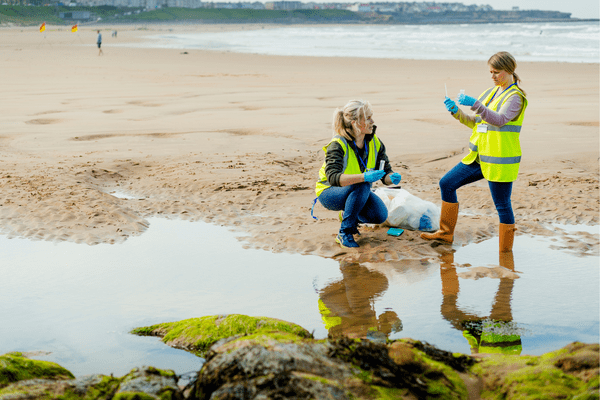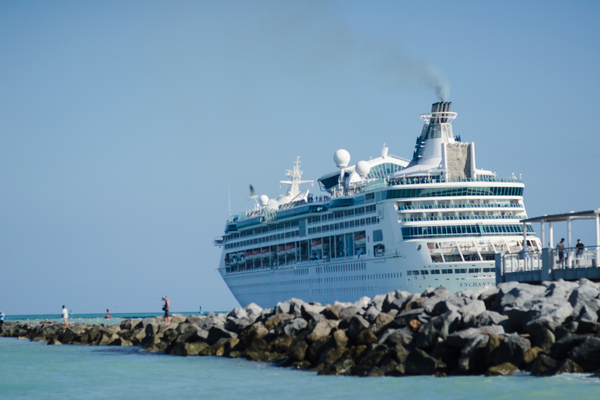Given the name of our website, it should come as no surprise to anyone that this will not be a post about bashing the cruise industry. (Not even a little bit.) Historically, cruise ships have often been slammed for their negative environmental impact. And, while it’s true that cruises aren’t the greenest form of travel, industry leaders and environmental protection agencies have been working to implement practices and protocols that yield better outcomes. So, just how bad are cruise ships for the environment anyway?
To reduce their overall carbon footprint, the cruising industry is taking steps to work towards a greener traveling experience. This includes using cleaner fuel sources, better waste management, and introducing LNG cruise liners.
Just How Bad Are Cruise Ships For The Environment?
Cruise liners have always been a popular form of travel, with the number of cruise passengers steadily increasing from 2009 to 2019. In fact, in 2019, data revealed that a whopping 29.7 million passengers were boarding cruise liners worldwide.
As a result of the COVID-19 pandemic, the cruising industry took a nosedive in 2020 and 2021. With travel under heavy restrictions, and passengers unable to travel, most liners were at a complete standstill. However, cruise lovers are flocking back on board with restrictions and travel bans lifting.
But the inevitable spike in cruise popularity has raised more questions from concerned tourists and travelers. Now that so many passengers are again taking to the seas, eco-conscious tourists are left wondering about the environmental impact the cruise industry may have.
In 2021, a study from the University of Exeter regarding the lax regulations of cruise liners and their environmental impact revealed that cruising was one of the primary sources of environmental pollution.

It’s no secret that, by their very nature, cruises will always have some degree of environmental impact. From carbon emissions to noise pollution, some negative environmental changes will likely arise for as long as the cruising industry stays in business.
However, the cruise industry is showing a concerted effort to improve its environmentally friendly practices and limit its impact as much as possible. So not all hope is lost!
With more environmental and governmental organizations working together to improve the previously loosely-regulated or unregulated marine tourism sector, the concerns about whether cruises are bad for the environment will soon be worries of the past.
As a passenger, it’s important to remember that not all cruise liners make the same efforts, though! And different cruise lines may employ different sustainability tactics. Suppose you want to know what green initiatives your cruise ship uses. In that case, you may have to do independent research before booking your family holiday ticket.
Small changes can have a big pay-off in helping the cruising industry work toward a greener future.
How The Cruise Industry Is Exacting Environmental Change
The cruise industry has been making positive and sustainable changes for years. While there is still a lot to achieve, most industry leaders are committed to making long-term changes to their ships.
There are several ways in which the cruise industry is exacting positive environmental change, including using exhaust gas cleaning systems, introducing LNG ships, and implementing new technologies. And, many cruise lines such as Royal Caribbean and Norwegian Cruises have been moving away from single-use plastic products. But exacting environmental change doesn’t stop with cruising corporations.
In addition to these initiatives, passengers are encouraged to study ways of keeping their own proverbial slate clean by ensuring good passenger practices while they’re on board.
Cleaner Fuel Sources
Because cruisers are constantly running, and with millions of passengers on board every year, their potential for carbon emission is astronomical. However, many cruise liners have begun to switch their engines to cleaner fuel alternatives to reduce their carbon footprint. One of the significant advancements in the cruise industry’s pursuit of cleaning up its act is the use of hybrid or dual-fuel engines.
Additionally, specific liners are working on designing and implementing exhaust cleaning systems. These systems, called Exhaust Gas Cleaning Systems or EGCS, are specifically designed to reduce a ship’s carbon emissions and overall air pollution. ECGS or Scrubbers also need to comply with certain international guidelines, meaning regulations will be much stricter within the industry.
While cleaner fuel sources aren’t enough to reverse the impact of cruise liners entirely, most ships have already implemented these changes, which is a step in the right direction! And, in conjunction with some of the other industry efforts, it may make a significant difference in the long run.
More Efficient Energy Sources
The cruise industry is also implementing major changes to energy sources for better overall efficiency. These changes form part of the industry’s shift in focus toward sustainable environmental protection.
With many liners using LED lights on board and recycling and distilling water for temperature regulation within the cabins, cruise ships are implementing several smaller changes as well.
And, speaking of the change to LED lights, cruise lines are changing their onboard power sources. With thousands of rooms on a cruise ship, most liners have an incredibly high need for energy. Like many eco-conscious homeowners, cruise ships have begun to harness solar and wind energy for cleaner and renewable power sources.
Not only do these small changes make a big environmental difference, but passengers may also be able to note the changes for themselves.
For example, travelers may note the addition of tinted windows to their favorite liners. But even the seemingly insignificant change in the window tint can make a big difference! With tinted windows, cabins are less likely to need temperature regulation, which reduces the need for water usage.
Industry leaders have already begun using more efficient fuel sources and engines. Still, energy-conserving appliances, systems, and light sources onboard the liners have helped to further the cause of environmental responsibility.
Responsible Waste Management
Cruise ships have gotten bigger and more elaborate over the years. With new ships having multiple levels, attractions, and entertainment spots on board, many cruises feel like miniature cities on the water. And this comparison couldn’t be more true regarding onboard waste.
In fact, even the older ships can fit hundreds of guests on board. And with more guests comes more waste.
Although waste disposal is closely regulated by provisions set out by organizations like MARPOL, the average amount of waste for a cruise ship is between two and seven tons a day. And that’s only solid waste on average-sized ships. It doesn’t begin to accommodate massive ships that allow thousands of passengers per trip.

In an effort to take out the trash and reduce their overall waste, the cruise industry has begun to ban single-use plastics on board their ships and develop more efficient waste removal and disposal systems. Additionally, this effort to reduce and recycle has significantly impacted the industry’s focus on environmental change.
Environmental Crew Training
Not all environmental efforts have to be about changing the physical aspects of the ship. Instead, one of the biggest changes cruise liners is making a start with their crew and passengers.
Most cruise lines are now required to fully train and educate their crew on the necessary environmental regulations to help them ensure compliance. In turn, the crew can assist and educate passengers so they can work together to make a difference. General compliance is expected – and encouraged – from both the rest of the crew and passengers.

If you’re planning a family cruise, you may want to familiarize yourself with the rules and regulations of your liner beforehand. Similarly, pay attention to any directions staff may give you when you board. Taking responsibility for your own actions can also go a long way in making cruises a more sustainable form of travel.
But here’s a short list if you want to know about some small changes you can make to enhance your (and your fellow passengers’) cruising experience.
What you can do to make eco-conscious choices during your cruise:
- One way to reduce your onboard water usage is to take shorter showers. While enjoying a long, hot shower after an exciting day of cruise activities may be nice, it helps to keep your showers short.
- Cabins can often get stuffy. But, instead of cranking up the cabin air conditioning, you may want to open your windows instead — if in a cabin where that’s an option.
- If you’re exploring on-shore, throw any waste you may have away before reboarding your cruise ship.
- When you’re on board, make a mental note of where the recycling bins are. Try to use these bins as frequently as you can.
- Don’t throw anything overboard.
- If you’re shopping on-shore, opt for reusable shopping bags rather than disposable ones.
- Use reusable straws and reusable bottles as far as possible. It may be handy to purchase some before your trip.
- Turn your lights and plugs off when they’re not in use. If you’re leaving your room, hit the light switch on your way out!
LNG Cruise Ships
With the need for a greener, cleaner, and more sustainable fuel source, cruise lines are turning to LNG-based ships. LNG, or liquified natural gas, is a clean-burning fuel that can help the cruising industry drastically reduce its carbon and greenhouse gas emissions. With several cruise ships trying to implement greener technology, several industry leaders are planning to roll out LNG fleets.
You may not know that some LNG cruise ships already exist, with a total of nine operational ships expected by the end of 2022. In 2018, the Carnival Corporation launched the first cruise ship LNG liner, the AIDANova. This green technology upped the ante amongst the rest of the industry, and several other cruising giants followed suit.
At the end of 2022, the list of operational LNG cruise liners will include the following:
- The AIDAnova (Carnival Corporation – 2018)
- The Costa Smeralda (Costa Cruises – 2019)
- The Carnival Mardi Gras (Carnival Corporation – 2020)
- The Iona (P&O Cruises – 2020)
- The AIDAcosma (Carnival Corporation – 2021)
- The Costa Toscana (Costa Cruises – 2021)
- The Disney Wish (Disney – 2022)
- The Carnival Celebration (Carnival Corporation – 2022)
- The MSC World Europa (MSC – 2022)
The cruising industry has no plans to stop there, though, and more than two dozen LNG ships are planning on taking to the seas before the end of 2028.
Some of the most noteworthy cruise ships that are planned for launch in the next few years include:
- The Icon of the Seas (Royal Caribbean – 2023)
- The Carnival Jubilee (Carnival Corporation – 2023)
- The MSC Euribia (MSC – 2023)
- The Utopia of the Seas (Royal Caribbean – 2024)
- Two unnamed Disney ships (Disney – 2024 & 2025)
Travelers will be happy to note that these coming cruise ships will be cleaner and greener. With the industry taking so many steps toward a more environmentally-friendly future, eco-conscious passengers and existing cruise fans alike will be able to enjoy cruising as their preferred method of traveling with family or friends.
Closing Thoughts
As a transportation method that relies on fuel, cruise ships are responsible for creating a large amount of CO2 emissions. Combine that with the huge amount of waste created by passengers, the cruise industry does have a significant impact on the environment. However, the cruise industry is taking steps to help manage both waste and emissions, including switching to LNG fuel.




